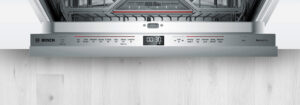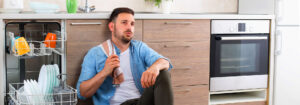Loading a dishwasher efficiently and effectively can help ensure that your dishes come out clean and undamaged. Proper placement of dishes, especially avoiding the blocking of spray arms, ensures an even distribution of water and detergent. This is crucial for consistent cleaning results.
Overloading or improper loading can put additional stress on the dishwasher’s components. Loading it correctly helps prevent unnecessary wear and tear, potentially extending the lifespan of the appliance.
Here’s a comprehensive guide on how to load a dishwasher correctly:
Before you start
Scrape and rinse
Scrape off large food particles from your dishes before loading them and rinse heavily soiled items. Large food particles can clog the dishwasher’s drain, filters, and spray arms over time. Rinsing helps remove these particles, preventing potential blockages and ensuring proper drainage.
Additionally, removing excess food ensures that the dishwasher’s cleaning mechanisms, such as spray arms and jets, can reach all surfaces of the dishes.
While some modern dishwashers are equipped to handle dishes with minimal pre-rinsing, it’s generally recommended to scrape off large food particles and give dishes a quick rinse before loading them.
Sort and group
By sorting and organising items, you can maximise the dishwasher’s capacity and fit more dishes into each load. This can be particularly beneficial when you have a large number of items to wash.
When utensils of the same type are grouped together, there is less chance of them nesting or sticking together during the wash cycle. This ensures that each utensil gets exposed to water and detergent for proper cleaning.
Dishwasher rack configuration
Top rack
The top rack of a dishwasher is designed to accommodate smaller and more delicate items. Here are common items that are typically placed on the top rack:
- Glasses, cups, and small bowls (upside down)
- Lightweight plastic items
- Utensils (forks, knives, spoons)
- Delicate Items
Some dishwashers have a separate utensil basket on the top rack. Utensils are typically placed in this basket with handles facing down for effective cleaning.
It is essential to load the top rack carefully, ensuring that items are secure and properly positioned to receive adequate water and detergent during the wash cycle.
Bottom rack
The bottom rack of a dishwasher is designed to accommodate larger and heavier items. In addition, the bottom rack is positioned closer to the dishwasher’s heating element, which aids in drying larger items more effectively.
Here are common items that are typically placed on the bottom rack:
- Dinner plates
- Pots, pans, and baking trays
- Larger bowls, serving dishes, and mixing bowls
- Cutting boards
Loading tips
Avoid blocking spray arms
The spray arms in a dishwasher are responsible for distributing water throughout the appliance during the wash cycle. Blocking the spray arms can result in uneven water distribution, leading to poorly cleaned dishes. Dishes that are not thoroughly rinsed may have detergent residue left on them after drying.
To avoid blocking the spray arms always load the dishes in a way that allows the spray arms to rotate freely. Be cautious with tall items that may obstruct the upper spray arm.
Face soiled surfaces inward
Place the side of dishes with food residue facing the centre of the dishwasher to ensure proper cleaning.
When the soiled surfaces of dishes face inward, they are more exposed to the water jets and detergent sprays from the dishwasher’s spray arms. This allows for better removal of food particles, grease, and other residues during the wash cycle.
Use dishwasher-safe items
Check if items are labelled as dishwasher-safe before loading them. Dishwasher-safe items are designed to withstand the heat and pressure inside a dishwasher without losing their colour or shape.
Items not labelled as dishwasher-safe, particularly certain plastics, may melt or deform under the high temperatures used in the dishwasher. This can potentially damage the dishwasher itself.
Some materials, especially certain types of plastics and coatings, may release harmful chemicals when exposed to high temperatures and detergents.
Detergent and Rinse Aid
Use dishwasher detergents specifically designed for automatic dishwashers. Dishwasher detergents contain ingredients that break down and remove food residues, grease, and stains from dishes. Using a dishwasher-specific detergent ensures optimal cleaning performance and helps prevent the build-up of residue on dishes.
Rinse Aid is optional but recommended. Rinse aid helps to prevent the build-up of mineral deposits and detergent residue on dishes. This is particularly important in areas with hard water, where mineral deposits can be more prevalent and can lead to cloudy glassware and dishes.
Many dishwasher models have adjustable rinse aid dispensers that allow you to customise the amount of rinse aid based on the hardness of your water.
Running the dishwasher
Choose the right cycle
Select the appropriate wash cycle for your load. Choosing the right cycle ensures that your dishes receive the appropriate combination of water pressure, temperature, and detergent for effective cleaning. Most dishwashers have options for heavy, normal, and light loads.
Run full loads
Wait until you have a full load before running the dishwasher to maximise water and energy efficiency. Dishwashers are designed to operate most efficiently when running a full load. The amount of water and energy used per cycle is typically the same, regardless of the size of the load.
While it’s advisable to run full loads whenever possible, it’s also important not to overload the dishwasher, as this can impact cleaning effectiveness. Be sure to follow the manufacturer’s guidelines for loading and use.
Clean the dishwasher filter
The dishwasher filter traps food particles and debris from dirty dishes to prevent them from circulating through the dishwasher’s pump, spray arms, and other components. Regular cleaning prevents the filter from becoming clogged, ensuring proper water circulation.
Cleaning the dishwasher filter is a relatively simple task. Most filters are removable and can be easily cleaned under running water or with a soft brush.
In summary, loading the dishwasher correctly is essential for efficient cleaning, preventing damage, and maximizing the appliance’s capacity. It not only ensures cleaner and more sanitary dishes but also contributes to the longevity and efficiency of the dishwasher itself.
By following these guidelines, you can load your dishwasher efficiently and help ensure that your dishes come out clean and in good condition. Always refer to your dishwasher’s manual for specific instructions and recommendations.








